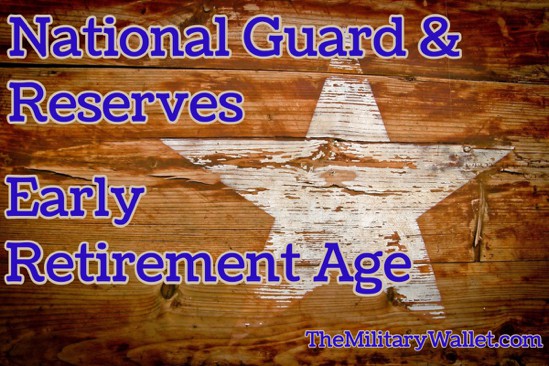Members of the National Guard, Air National Guard and military Reserves who have met the 20-year service requirement are generally eligible for receiving retirement benefits at age 60. However, the 2008 National Defense Authorization Act (NDAA) authorized early retirement benefits for members of the Reserve Corps who meet certain criteria. The criteria were later updated with the 2015 NDAA to make it easier for certain members of the Reserve Components to qualify for early retirement pay.
Note: Early Retirement only is only applicable to early retirement pay. TRICARE benefits eligibility still begins at age 60. See below for more information on how you can obtain affordable health care before TRICARE kicks in.
Under the 2008 National Defense Authorization Act, members of the Reserve Component who served at least 90 days during a fiscal year on a deployment in support of overseas operations such as the Iraq or Afghanistan campaigns are authorized to retire three months early for each 90 day period they served in any given fiscal year. This only applies to members of the Guard or Reserves who participated in a qualifying active-duty mobilization after Jan. 28, 2008, which is the date the Act was signed into law. Service on or before this date does not count toward early retirement.
In January 2013, Congress expanded the criteria for early retirement by authorizing additional eligibility requirements. The new rules allow members of the Guard or Reserves to count activations for national emergencies including natural disasters such as earthquakes, hurricanes, tornadoes, floods, etc. Members of the Reserve Components may also be eligible to retire early if they were in a Warrior Transition unit and were injured while mobilized for responses as mentioned above.
The 2015 National Defense Authorization Act further expanded benefits. The 2015 NDAA removed the requirement for the 90 days of active duty service to be performed within the same fiscal year – activations could cross into consecutive years. However, this only applies to activations beginning FY15 and later. Further details below.
Early Retirement from the Guard and Reserves
How to Qualify for Retirement from the Guard & Reserves
A member must serve a full 20-year service obligation before being eligible to retire from the National Guard or Reserves. Members can retire as soon as they have 20 good years of service, but they are considered gray area retirees until they reach age 60. In general, they will be eligible to access base activities such as the gym, MWR, commissary and base exchange privileges. They would only be eligible to begin receiving other retirement benefits at age 60, including pay and medical benefits.
How Early Retirement Works
To be eligible for early retirement, a member of the Reserve Corps must still complete the 20-year service requirement. How early they can retire depends on the number of active duty days they served on a mobilization after Jan. 28, 2008.
Early retirement reduces the eligibility age for receipt of Reserve retired pay by three months for each aggregate of 90 days of qualifying active duty performed within a fiscal year. For example, if you served 90-179 days in a fiscal year, you could only retire 3 months early. If you served 180 or more days in a fiscal year you could be eligible to retire 6 months early.
Important Note for Deployments that Started Prior to FY 2015
The entire 90 days must also be served during the fiscal year. If you served 90 consecutive days, but part of your mobilization was before the fiscal year end and part was during the new fiscal year, then the 90-day mobilization wouldn’t count toward early retirement. This makes the timing of the deployment very important when determining early retirement eligibility.
The good news is that your mobilization doesn’t need to be continuous. Your service would meet the early retirement requirements if you served 30 days at the beginning of the fiscal year and 60 days at the end of the fiscal year, so long as all 90 days were served within the same fiscal year. Many Guard and Reserve members are often mobilized for short time frames, including 15- or 30-day rotations.
You can add all of these together to meet the 90-day requirement, so long as they all fall within the same fiscal year. If you find yourself in a similar situation, then be sure to keep good track of your mobilization dates so you know whether or not your mobilizations will help you qualify for early retirement.
90 Day Early Retirement Periods are Cumulative
Servicemembers can qualify for more than one 90 day early retirement period in a Fiscal Year. For example, someone who served 90+ days in FY 2009, 180+ days in FY 2010, and 90+ days in FY 2011, and 90+ days in FY 2012 would be eligible to retire at age 58 and 9 months (five three month periods, or 1 year 3 months early). The only rule for the cumulative early retirement benefit is that members cannot retire before age 50.
Update 2015 National Defense Authorization Act
The 2015 National Defense Authorization Act makes it easier for Reserve Corps members to qualify for early retirement when called to active duty. Prior to FY 2015, members had to serve 90 days on active duty during a fiscal year in order to be eligible to retire early. Service time that crossed a fiscal year didn’t count toward early retirement unless they had 90 or more days during a fiscal year, making the timing of the deployment very important when determining early retirement eligibility.
The new law allows that time to cross into the consecutive fiscal years. However, this only applies to deployments that started after 30 September, 2014 (or deployments that began in FY 2015).
This law is not retroactive to 28 January, 2008, which is the date of the original early retirement rule. So to recap:
- Early retirement qualifying service (28 January 2008 – 30 September 2014): Must serve 90 days on active duty within a fiscal year.
- Early retirement qualifying service (01 October 2014 – present): Must serve 90 days on active duty; service time can cross into consecutive fiscal years.
You can read more about this update in the following resources:
Qualifying and Non-Qualifying Service for Early Retirement
Qualifying Service
Most active duty time counts for early retirement, including deployments in support of overseas operations, mobilizations for natural emergencies which are authorized by the governor and paid for by federal funds, and other active duty service periods including training and attending military schools. However, not all service counts toward early retirement.
Non-Qualifying Service
You must have been a member of the Guard or Reserves when you were activated for the qualifying service. Members who originally joined the service as active duty then later transitioned to the Guard or Reserves are not able to count their previous active duty service toward early retirement.
Other ineligible Guard or Reserve duty includes actions such as performing weekend drills, 2 weeks annual training, those in full-time AGR or TAR status, muster duty, those who were activated for courts-martial or disciplinary reasons, and those who were listed as not participating at a satisfactory level.
Meeting Eligibility Requirements is Only Part of the Battle
It’s up to the member to be aware of these changes and file for early retirement. In these instances, you will need to have proof of your activation, including the reason and the duration of time you were activated.
This is where your mobilization orders and DD Form 214 are essential. As you know, your DD Form 214 is issued when you are released from active duty service. This is a different form than your DD Form 256, which is the Honorable Discharge paperwork you receive when you separate from the Guard or Reserves.
Keep Good Records of Your Service
Your mobilization orders should state the reason for your mobilization or activation, as will your DD Form 214. In order to qualify for the early retirement under the new rules, you will need to have either Title 10 or Title 32 orders with the following annotation: 12301(a), 12301(d), 12301(h), 12302, 12304, 12305 or 12306.
Here is a reference from the US Army that covers other forms:
AD, for this purpose, means service pursuant to a call or order to AD on orders specifying, as the authority for such orders, a provision of law referred to in section 101(a) (13)(B), and performed under section 688, 12301 (a), 12302, 12304, 12305, 12406, and chapter 15 (insurrection), or under section 12301 (d) of Title 10 USC. Active Guard Reserve (AGR) duty under section 12310 of Title 10 USC, will not be included as service on active duty for determining eligibility for reduced age retired pay for non-regular service.
Active service includes service on AD as defined in subparagraph 6.5.2.2 of DoDI 1215.07, and Full-time National Guard when under a call to active service by a governor and authorized by the President or the Secretary of Defense under section 502(f) or 115 and 502 (f) of Title 32 USC for purposes of responding to either a national emergency declared by the President or a national emergency supported by Federal funds.
Because much of this is up to you filing the required paperwork on time, you need to keep excellent records. If you notice discrepancies in your paperwork, contact your unit immediately to have your records corrected. If you have since left your unit and are no longer serving, you may need to contact the National Archives. We have an article on requesting military records.
If in doubt, try speaking with your unit personnel section, or try contacting your HHQ personnel section for further clarification.
Early Retirement is For Pay; Other Benefits Come at Age 60
While your deployments can start the clock earlier for your retirement pay and benefits such as access to the commissary or base exchange, early retirees will have to wait until age 60 to be eligible for certain other benefits, such as TRICARE Prime benefits and Space-A travel eligibility.
TRICARE for Life eligibility begins at age 65.
Please see this article for more information about health care options:
- Health Insurance Options After Leaving the Military
- Health Care Options for Retired Guard or Reserve Members
- VA Health Care Eligibility
The above references will help you plan for your health care needs while awaiting TRICARE Prime eligibility, and later, TRICARE for Life.




Comments:
About the comments on this site:
These responses are not provided or commissioned by the bank advertiser. Responses have not been reviewed, approved or otherwise endorsed by the bank advertiser. It is not the bank advertiser’s responsibility to ensure all posts and/or questions are answered.
Victor H Harris says
The HQ of the South Carolina Guard (G1/HR) would have to address this. You do not need the actual unit because according to the narrative you wrote there is no question on his time served. When someone has reached 20 eligible years they receive their 20 yr letter. It does not show up years down the line. So your uncle has never reached 20 yrs. Reach out to the HQ G1 or even the Inspector general for assistance. At this point you are asking for an exception. Not a correction or injustice. Your Uncle made a bad mistake by not waiting for for his 20 year letter. Most people with 20 years of service know better than to leave before you are sure you have paperwork in hand. The ABCMR will not act on it until the command (SCARNG) has had the opportunity to address the issue. Good luck.
Ray Stargel says
If the early retirement (drop program) is going by the government fiscal year which is October to October and the bill passed for this effective date is Jan 28, 2008, does that mean the qualifying service starts October 1, 2007, (beginning of the fiscal year) moving forward or the qualifying service starts on Jan 28, 2008, which is not the beginning of the fiscal year.
The reason I am asking is I deployed several times since 2001 both to Iraq and Afghanistan, the only deployment in my case that falls under the drop program (early retirement) was from September 2007 to December 2008 but if they are only going to count after Jan 28, 2008, that cuts down on when my retirement takes effect.
In all the research I have read on the drop program they reference the fiscal year for the program but there is no clarification if they mean October 1, 2007, since that is the start of the fiscal year, or they are going by when the bill was signed Jan 28, 2008. which approximately four months into the fiscal year.
Ryan Guina says
Hello Ray, this is quoted from the article, “This only applies to members of the Guard or Reserves who participated in a qualifying active-duty mobilization after Jan. 28, 2008, which is the date the Act was signed into law. Service on or before this date does not count toward early retirement.”
It appears you will get early retirement credit for part of your deployment but not for the time served before January 28, 2008.
Amanda says
What is the rationale for not covering the OIF I – OIF IV (all prior to 2008)? I served, boots on ground, in Kuwait/Irag from DEC 2004 to JAN 2006. As I understand, none of this time counts toward early retirement?
Bob Stephenson says
This site is misleading. Why can’t I access a simple calculator? All I want to do is enter 1) Rank retired at 2) Total Points 3) Sat years, and get an estimate of what my retired pay will be when I turn 60. All of the “sponsored” links just produce another search engine result under the general topic of retirement income.
Ryan Guina says
Hello Bob, this article is about how National Guard and Reserve members can qualify for early retirement age. This is not a calculator for military retirement benefits. The calculation is not as simple as it appears on the surface and will depend on the servicemember’s retirement rank, their total number of points, and other factors. I recommend researching a specific retirement calculator to help you find the answers to your query.
Best wishes.
Larry says
Ryan,
I’m attempting to apply for the program of reduced age retirement. The issue is that I’m a IMA/Reservist and don’t have a orderly room to ask these questions. Can you send me the Reduced retired pay age application? Or tell me the form number. I’m 57 now and have about 2 and half years of qualify time. Thank you for your time. Have a great day.
Larry
Ryan Guina says
Hello Larry, I don’t have a copy of the reduced age application. You will need to work with your branch of service’s main personnel or HR office (Army HRC, AFPC, BUPERS, etc.). They should be able to help you apply for your military retirement benefits. I hope this points you in the right direction. I wish you the best, and thank you for your service!